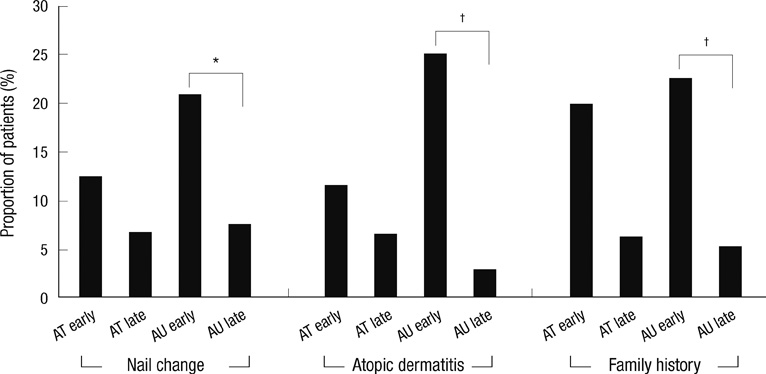J Korean Med Sci.
2012 Jul;27(7):799-802. 10.3346/jkms.2012.27.7.799.
Clinical Characteristics and Prognostic Factors in Early-Onset Alopecia Totalis and Alopecia Universalis
- Affiliations
-
- 1Department of Dermatology, Seoul National University College of Medicine, Seoul, Korea. oskwon@snu.ac.kr
- 2Institute of Dermatological Science, Seoul National University, Seoul, Korea.
- KMID: 2157927
- DOI: http://doi.org/10.3346/jkms.2012.27.7.799
Abstract
- Alopecia totalis (AT) and alopecia universalis (AU), severe forms of alopecia areata (AA), show distinguishable clinical characteristics from those of patch AA. In this study, we investigated the clinical characteristics of AT/AU according to the onset age. Based on the onset age around adolescence (< or > or = 13 yr), 108 patients were classified in an early-onset group and the other 179 patients in a late-onset group. We found that more patients in the early-onset group had a family history of AA, nail dystrophy, and history of atopic dermatitis than those in the late-onset group. These clinical differences were more prominent in patients with AU than in those with AT. In addition, significantly more patients with concomitant medical disorders, especially allergic diseases were found in the early-onset group (45.8%) than in the late-onset group (31.2%). All treatment modalities failed to show any association with the present hair condition of patients. In the early-onset group, patients with AU or a family history of AA showed worse prognosis, whereas this trend was not observed in the late-onset group. Systemic evaluations might be needed in early-onset patients due to the higher incidence of comorbid diseases. It is suggested that patients with AU or family history of AA make worse progress in the early-onset group than in the late-onset group.
Keyword
MeSH Terms
Figure
Cited by 2 articles
-
Differences in Comorbidity Profiles between Early-Onset and Late-Onset Alopecia Areata Patients: A Retrospective Study of 871 Korean Patients
Noo Ri Lee, Bo-Kyung Kim, Na Young Yoon, Sung-yul Lee, Seok-Yong Ahn, Won-Soo Lee
Ann Dermatol. 2014;26(6):722-726. doi: 10.5021/ad.2014.26.6.722.Analysis of Personality Trait in Patients with Alopecia Areata
Jeong-Min Kim, Hoon-Soo Kim, Hyun-Chang Ko, Byung-Soo Kim, Moon-Bum Kim
Ann Dermatol. 2017;29(6):815-816. doi: 10.5021/ad.2017.29.6.815.
Reference
-
1. Chua-Ty G, Goh CL, Koh SL. Pattern of skin diseases at the National Skin Centre (Singapore) from 1989-1990. Int J Dermatol. 1992. 31:555–559.2. Alkhalifah A, Alsantali A, Wang E, McElwee KJ, Shapiro J. Alopecia areata update: part I. Clinical picture, histopathology, and pathogenesis. J Am Acad Dermatol. 2010. 62:177–188.3. MacDonald Hull SP, Wood ML, Hutchinson PE, Sladden M, Messenger AG. Brithsh Association of Dermatologists. Guidelines for the management of alopecia areata. Br J Dermatol. 2003. 149:692–699.4. Walker SA, Rothman S. A statistical study and consideration of endocrine influences. J Invest Dermatol. 1950. 14:403–413.5. De Waard-van der Spek FB, Oranje AP, De Raeymaecker DM, Peereboom-Wynia JD. Juvenile versus maturity-onset alopecia areata: a comparative retrospective clinical study. Clin Exp Dermatol. 1989. 14:429–433.6. Goh C, Finkel M, Christos PJ, Sinha AA. Profile of 513 patients with alopecia areata: associations of disease subtypes with atopy, autoimmune disease and positive family history. J Eur Acad Dermatol Venereol. 2006. 20:1055–1060.7. Tosti A, Bellavista S, Iorizzo M. Alopecia areata: a long term follow-up study of 191 patients. J Am Acad Dermatol. 2006. 55:438–441.8. Kavak A, Yeşildal N, Parlak AH, Gökdemir G, Aydoğan I, Anul H, Baykal C. Alopecia areata in Turkey: demographic and clinical features. J Eur Acad Dermatol Venereol. 2008. 22:977–981.9. Green J, Sinclair RD. Genetics of alopecia areata. Australas J Dermatol. 2000. 41:213–218.10. McDonagh AJ, Tazi-Ahnini R. Epidemiology and genetics of alopecia areata. Clin Exp Dermatol. 2002. 27:405–409.11. Shellow WV, Edwards JE, Koo JY. Profile of alopecia areata: a questionnaire analysis of patient and family. Int J Dermatol. 1992. 31:186–189.12. Shin N, Kim SH, Cho S, Whang KK, Hahm JH. The impact of childhood atopic dermatitis on their families. Korean J Dermatol. 2000. 38:494–499.13. Kliegman RM. Behrman RE, Kliegman R, Nelson WE, editors. Adolescent development. Nelson textbook of pediatrics. 2011. 19th ed. Philadelphia: W.B. Saunders;1778–1780.14. Sharma VK, Muralidhar S, Kumar B. Reappraisal of Ikeda's classification of alopecia areata: analysis of 356 cases from Chandigarh, India. J Dermatol. 1998. 25:108–111.15. Kim YJ, Kim BJ, Ro BI. A clinical and psychological study for alopecia areata in children. Korean J Dermatol. 2003. 41:179–186.16. Paus R, Olsen EA, Messenger AG. Wolff K, Goldsmith LA, Katz SI, Gilchrest BA, Paller AS, Leffell DJ, editors. Hair growth disorder. Fitzpatrick's dermatology In general medicine. 2008. 7th ed. New York: McGrow Hill;753–777.17. Alkhalifah A, Alsantali A, Wang E, McElwee KJ, Shapiro J. Alopecia areata update: part II. Treatment. J Am Acad Dermatol. 2010. 62:191–202.18. Porter D, Burton JL. A comparison of intra-lesional triamcinolone hexacetonide and triamcinolone acetonide in alopecia areata. Br J Dermatol. 1971. 85:272–273.19. Akar A, Arca E, Erbil H, Akay C, Sayal A, Gür AR. Antioxidant enzymes and lipid peroxidation in the scalp of patients with alopecia areata. J Dermatol Sci. 2002. 29:85–90.20. Colombe BW, Lou CD, Price VH. The genetic basis of alopecia areata: HLA associations with patchy alopecia areata versus alopecia totalis and alopecia universalis. J Investig Dermatol Symp Proc. 1999. 4:216–219.21. Lu W, Shapiro J, Yu M, Barekatain A, Lo B, Finner A, McElwee K. Alopecia areata: pathogenesis and potential for therapy. Expert Rev Mol Med. 2006. 8:1–19.
- Full Text Links
- Actions
-
Cited
- CITED
-
- Close
- Share
- Similar articles
-
- Efficacy of Oral Tofacitinib in Patients with Alopecia Areata: Tofacitinib Was Ineffective for Recalcitrant Alopecia Totalis of a Long Duration
- A clicical study for alopecia totalis and alopecia universalis
- Prognostic Factors Influencing Therapeutic Effect in Methylprednisolone Pulse Therapy for Alopecia Areata
- A Case of Alopecia Universalis in a Gravida
- Effect of Methyl - Prednisolone Pulse Therapy on Alopecia Totalis


